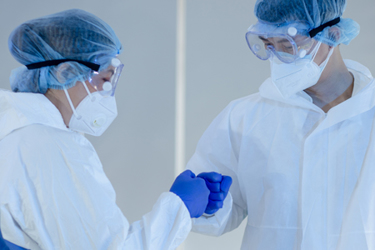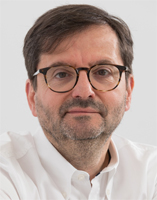"Nobody Should Work Alone": An Outsourcing Philosophy

By Louis Garguilo, Chief Editor, Outsourced Pharma

Miguel Forte, CEO, Bone Therapeutics, a clinical-stage cell-therapy company in Gosselies, Belguim, thinks I’m overly bifurcated in my approach to outsourcing development and manufacturing.
“It's interesting that everything is a combination of internal and external,” Forte tells me in a soothing professorial voice. In fact, he’s a Fellow of the Faculty of Pharmaceutical Medicine of the Royal College of Physicians, and Associate Professor in Health Sciences and Pharmacy at the University of Lisbon.
Outsourcing is not an equation of “what we do vs. what they do”; it’s complimentary over contrasting.
And he’s got quite the example.
Facility Fun

And so Bone ended up selling the facility – to Catalent – under specific right-of-manufacturing and other use agreements.
“Nevertheless,” Forte continues, “we maintain in-house knowhow and experience. For example, we can perform scale-ups, but of course those also require collaborations with others, in terms of equipment, performance testing, and other services. To me, it's always a combination.”
As Forte mentioned, the GMP facility was originally built to serve autologous needs; today it is also capable of allogeneic production – for new programs like Bone’s:
The company is currently focused clinically on ALLOB, an allogeneic “off-the-shelf” cell-therapy product derived from stem cells of healthy donors. The program is in Phase II studies for the treatment of delayed-union fractures and spinal fusion. (Bone is also developing an enhanced visco-supplement (JTA-0040) for the treatment of knee osteoarthritis.)
“There was no need to carry the cost and the structure of the launch facility,” explains Forte; better to enable those workers more opportunities under a CDMO – while Bone acquired a close CDMO relationship as well.
Of course, not every biopharma has a facility to sell in order to forge a CDMO relationship. Nonetheless, how did Bone select the CDMO for that deal? The answer to that is instructive to all our readers.
Three Attributes Of A CDMO
Forte describes three key attributes for selecting any partner in the pursuit of development and manufacturing services:
- “First of all, you select a CDMO relationship based on quality, but also the ability to deliver that quality.”
- Second is “the ability to interact, but I wouldn't necessarily call it a cultural fit.”
- Third – as you may have anticipated – “is consideration of cost.”
“Those are the parameters,” Forte says. “However, at the same time, the application of which is also prompted by the evolution and timing of your company.”
As an example of these tenets in an evolutionary practice, he circles back to the sale of his manufacturing facility.
“We sold it to a certain CMO which we carefully selected,” he says, “with the capacity to perform at a high level of quality, the ability to interact with us, and reasonable pricing, with the dependent circumstances of our company’s evolution.”
These concepts and circumstances may bring you to a relationship with a CDMO you’ve already worked with and have experiences with, or perhaps a professional in your organization may have previous experience there.
In some cases, the CDMO occupying a global footprint, or offering specific integrated service options, is most vital to your development and manufacturing glide path. Or you discover both your organization, and the service provider are heading in the same direction scientifically, operationally, or dare we say, philosophically.
“Nobody should work alone,” is Forte’s bottom line.
It’s What We Do
“Contracting is part of what we do, because you must compliment what you know with what others know,” Forte explains of the emerging biopharma condition. “It's that combination that delivers the best outcomes.”
This necessitates biopharma need to “choose people who know more than you on a specific topic.” In other words, he says, “they have the competencies that compliment those you have.”
And back to his second of the three key tenets: “CDMOs must interact so you are able to work within this complimentary fashion.”
But there’s a caution here. Forte suggests the often-used description of “fit” is in fact an overlay, and he speaks more precisely of “relational delivery” of materials and services.
Although not keen on the term “cultural fit,” he believes factors of culture and language can be important at times, as well as relative sizes of organizations, or proximity, and other influencing factors.
But all these factors, he says, should be determined to the extent possible prior to the full consideration of pricing. Of this final attribute:
“Cost is important, but it should come after you have established the quality, ability, and capacity to work together. Obviously, this goes for clinical outsourcing and manufacturing, but also other supply-chain, analytical-support, and testing needs.”
Forte believes his varied experiences in the industry – clinician, academic, roles in regulatory bodies (e.g., multiple executive positions in the International Society for Cell And Gene Therapy (ISCT), as well as earlier positions at organizations like Abbot and BMS – inform his outsourcing philosophy.
“I understand we have to recognize there are always multiple players, and it's the combination of those players that add the value to whatever project you're pursuing.”
But I wonder:
Particularly for emerging biopharma – such as Bone – that are introducing new science and technology applications to the pursuit of challenging targets, is it always possible to find someone smarter who can lend support?
“Not always,” Forte says with a laugh, “because if everybody else is smarter than you on all grounds, then you bring no value. You should just watch.”
-------------
Next up, we’ll learn what Forte foresees as the inevitable evolution of autologous to allogeneic … and beyond; and of a certain critique he has of the up-to-now utilization of Mesenchymal Stem Cells (MSCs), the adult stem cells isolated from sources that can differentiate into other types of cells.
